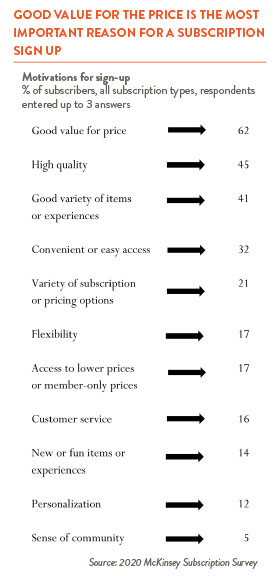We’ve fully embraced the rental and subscription economies, many would say. We don’t buy software in shrink-wrapped packages. We subscribe. We may buy a movie or music occasionally, but we more likely access our media through streaming services. We can get fashion from Rent the Runway. We can rent furniture too – and not the dreadful overstuffed items of old, but sleek, modern pieces where the monthly fee includes delivery, assembly, and pickup when we’re ready for a different look. We even can subscribe to a Volvo with the insurance and maintenance covered.
The benefits of renting or subscribing over owning can have appeal: You don’t have to commit. You can try out different brands and experiences, which millennial and Gen-Z folks are especially keen on. You don’t have to worry about obsolescence. You can feel good about reusing instead of discarding. And you don’t have to worry about service or maintenance.

When people talk about the subscription economy, they can mean different things. Sometimes they are talking about digital products like software and media that earn recurring revenues. Sometimes they are talking about the recurring revenues from physical things that need replenishment, like meal kits, shaving razors, or subscription boxes filled with household goods. And sometimes they are talking about what interests us here — low-commitment ways to access physical products without having to own them.
In this case, companies grant access to their products but retain full ownership while they manage them. Sometimes, these companies operate closed loops that reuse assets and reduce waste – the idea of the “circular economy.” And always, these arrangements involve a shift in our relationship toward physical goods. It’s quite a different mindset to own your furniture than it is to have a company manage the furniture assets in your home. The plus is you’ll never have to call 1-800-Got-Junk to have your sofa hauled away. And if you pick the right company, you can rest assured it won’t go into a landfill but will get refurbished for the next customer.
Usership works for business customers too. Michelin leases tires to commercial fleets – and includes digital sensors to monitor performance metrics. Signify, the lighting division of what formerly was known as Philips, offers “lighting as a service.” It designs, installs, operates, and maintains your facility’s lighting at what it says will be significant savings – and customers never have to change a lightbulb.
It’s become popular to say that ownership is dead and that usership is in – and it does sound seductive – but it’s not completely true. Not every product can be turned into a service. Customers must see the value in a subscription, and sometimes the value isn’t there. A recent article in Harvard Business Review (Atasu, Dumas, and Wassenhove, July/August 2021) noted that when Slovenian company Gorenje tried leasing its washing machines, it didn’t work because customers realized it would be more expensive to lease over the life of the machine than to own.
Another example is when the sustainability-minded commercial flooring company Interface, based in Atlanta, tried selling flooring as a service in the 1990s. The company offered installation, maintenance, and removal for a monthy fee so it could gain control over the entire product lifecycle and keep used product out of landfills. Perhaps that program was just ahead of its time. But again, customers couldn’t see the value because they didn’t track maintenance costs separately. Interface later pivoted successfully to manufacturing modular carpet tiles out of sustainable materials that dramatically reduced its carbon footprint.
According to the authors of the Harvard Business School Review article, complex items with high embedded value are particularly well suited for rental. But other things to consider are whether there is high salvage value and a healthy secondary market, which would drive many to prefer buying and reselling over renting.
In addition, items with low intrinsic value in terms of materials can sometimes work well too — if there is high brand value. That is why fashion subscriptions like Rent the Runway work well. The value for subscribers is there.